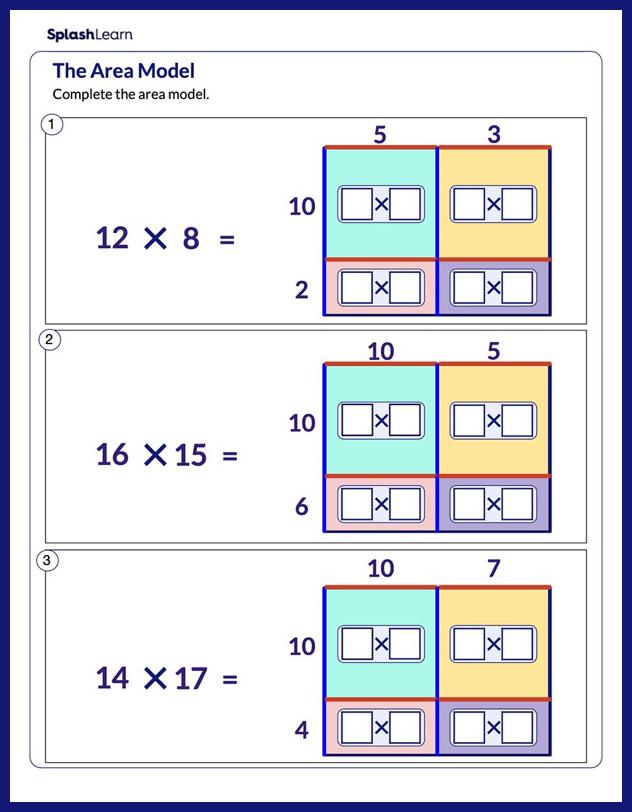What Is the Area of Trapezium?
The area of trapezium is the region covered by a trapezium in 2D plane. It is measured in square units. It is given by
Area of Trapezium $= \frac{1}{2}\times$ Sum of parallel sides $\times$ height
A trapezium (also known as trapezoid in the US) is a 2D shape. To be more specific, it is a quadrilateral as it has 4 sides.
Observe the given diagram.
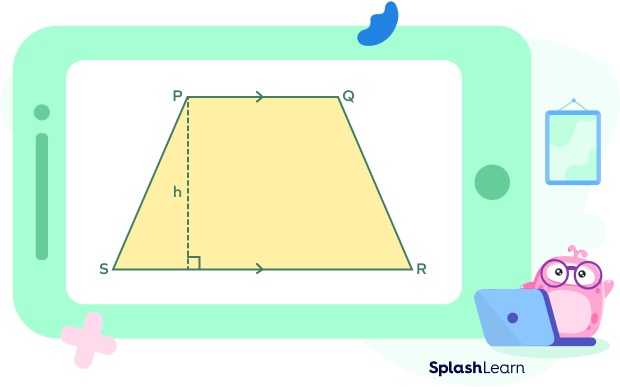
Here are the important parts and terms related to the trapezium PQRS.
- Bases of the trapezium: the parallel sides (PQ || RS)
- Legs of the trapezium: The non-parallel sides (PS and QR)
- Altitude or height of the trapezium: The perpendicular distance between the two parallel sides
Here, the area of trapezium is the shaded region. The area of trapezium depends on the lengths of the parallel sides and the height.
Recommended Games
Area of Trapezium Formula
The formula to calculate the area of the trapezium is given as
Area of Trapezium $= \frac{1}{2} \times$Sum of parallel sides $\times$ height
Area of trapezium $= \frac{1}{2} \times (a + b)\times h$
where
a and b are the lengths of parallel sides,
h is the height (perpendicular distance between the parallel sides)
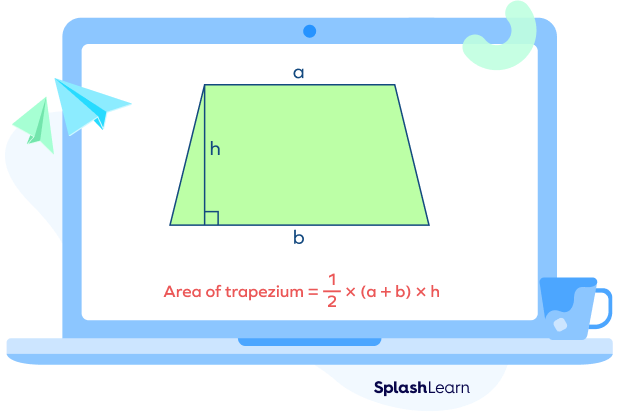
Recommended Worksheets
How to Derive the Area of Trapezium Formula
Let’s understand the derivation of the formula or equation for the area of trapezium.
Consider a trapezium ABCD. To find the area of trapezium ABCD, we will divide it into two right triangles and a rectangle, since we know how to calculate the area of these shapes.
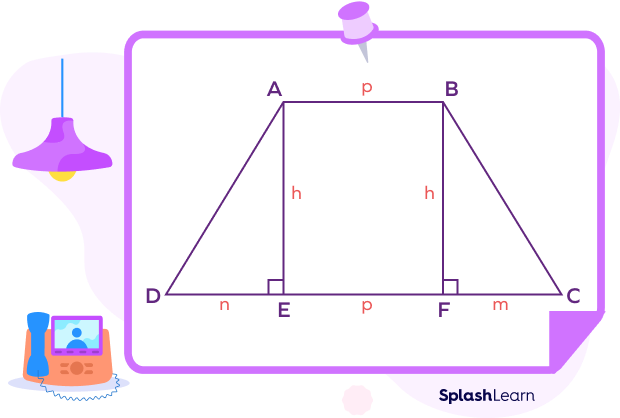
Construction:
- Draw a perpendicular AE such that we get a right-angled triangle △ AED with DE = n units and AE = h units
- Draw a perpendicular BF such that △BFC is a right-angled triangle with FC = n units and BF = h units
Note that AEFB is a rectangle formed such that AE = BF = h units and AB = EF = p units.
Area of trapezium ABCD = Area of △AED + Area of the rectangle AEFB + Area of △ BFC
Area of a triangle is given by
Area of triangle $= \frac{1}{2} \times$ base $\times$ height
Area of ADE $= \frac{1}{2} \times n \times h$ ———- (i)
Area of BFC $= \frac{1}{2} \times m \times h$ ———- (ii)
Area of the rectangle is given by
Area of rectangle $=$ length $\times$ breadth
So, the area of the rectangle AEFB is
Area of AEFB $= p \times h$ ———- (iii)
By adding equations (i), (ii), and (iii), we have
Area of trapezium ABCD $= (\frac{1}{2} \times n \times h) + (\frac{1}{2} \times m \times h) + (p \times h)$
Area of trapezium ABCD $= \frac{nh}{2} + \frac{mh}{2} + ph$
Area of trapezium ABCD $= \frac{nh + mh + 2ph}{2}$
Area of trapezium ABCD $= \frac{1}{2} \times h \times \left[p + (p + n + m)\right]$ —— (v)
Here, we notice that
CD $= p + n + m$
AB$ = p$
Put the value of q in equation (v).
Area of trapezium ABCD $= \frac{1}{2} \times [AB + CD] \times h$
Area of trapezium ABCD $= \frac{1}{2} \times$ Sum of parallel sides$\times$ height
How to Find the Area of Trapezium
Step 1: Note down the dimensions, such as the lengths of the bases (parallel sides) and the height of the trapezium. Make sure that the dimensions of the trapezium are in the same units. If the dimensions are in different units, then convert them to the same unit.
Step 2: Calculate the sum of the bases. Multiply the sum by the height.
Step 3: Multiply the product obtained in Step 2 by $\frac{1}{2}$ or you can divide the product by 2.
Step 4: Write the area in square units (inches², feet², etc.).
Let’s understand how to find the area of trapezium with an example:
Example: What is the area of trapezium ABCD?
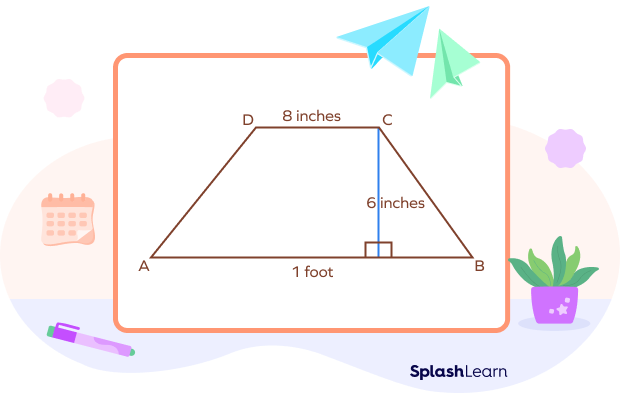
Solution:
AB = a = 1 foot
CD = b = 8 inches
Height = h = 6 inches
Since the dimensions are not in the same unit, we need to convert them to one unit. 1 foot = 12 inches
Therefore, a = 12 inches
Area of trapezium $= \frac{1}{2} \times (a + b) \times h$
Area of trapezium $= \frac{1}{2} \times (12 + 8) \times 6$
Area of trapezium $= \frac{1}{2} \times 20 \times 6$
Area of trapezium $= 60$ square inches
Facts about Trapezium
- Area of trapezoid formula is also written as
$A = \frac{1}{2} \times$Sum of parallel sides $\times$ Distance between the parallel sides - If the legs or the non-parallel sides of a trapezium are of equal length, the trapezium is called an isosceles trapezium.
- If all the sides and angles of a trapezium are of different measures, the trapezium is called a scalene trapezium.
- The line segment connecting the midpoints of the non-parallel sides (legs) of a trapezoid is called the mid-segment. It is parallel to the bases.
- There are different definitions of trapezium and trapezoid in different regions.
- In the US (some regions), a trapezoid is defined as a quadrilateral with at least one pair of parallel sides, while a trapezium is defined as a quadrilateral with no parallel sides.
- In the UK, a trapezium is defined as a quadrilateral with at least one pair of parallel sides, which aligns with the American definition of a trapezoid.
- In Canada, a trapezoid has an inclusive definition in that it’s a four sided-polygon with at least one pair of parallel sides. It is considered as an inclusive definition, since it makes a parallelogram a special trapezium/trapezoid.
Conclusion
A trapezium is a simple yet interesting shape in geometry. The concept of the area of trapezium is used in many physics concepts and also in construction projects. Get a better grasp of the concept with the help of examples and practice questions and excel in your math tests.
Solved Examples on the Area of Trapezium
1. A trapezium has base lengths a = 22 inches and b = 26 inches respectively. The distance between them is 18 inches. Find the area of trapezium.
Solution:
a = 22 inches
b = 26 inches
Distance between parallel sides = h = 18 inches
Area of trapezium $= \frac{1}{2} \times (a + b) \times h$
Area of trapezium $= \frac{1}{2} \times (22 + 26) \times 18$
$= \frac{1}{2} \times 48 \times 18$
Area of trapezium $= 432$ inches²
2. The area of the given trapezium is 352 feet². Find the value of a.
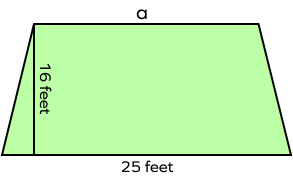
Solution:
a = ?
b = 25 feet
h = 16 feet
Area of trapezium = 352 square feet
Area of trapezium $= \frac{1}{2} \times (a + b) \times h$
$352 = \frac{1}{2} \times (a + 25) \times 16$
$(a + 25) = \frac{352 \times 2}{16}$
$(a + 25) = 44$
a = 19 inches
3. Find the altitude of a trapezium whose area is 85 feet² and the length of the parallel sides are 15 feet and 25 feet, respectively.
Solution:
Using the value of the area of a trapezium when height is not given, the calculations will be as follows:
a = 15 feet
b = 25 feet
Area = 85 feet²
Area of trapezium $= \frac{1}{2} \times (a + b) \times h$
$85 = \frac{1}{2} \times (15 + 25) \times h$
$h = \frac{85\times 2}{(15 + 25)}$
$h = \frac{85\times 2}{40}$
h = 4.25 feet
Therefore, the altitude is 4.25 feet.
4. The area of a trapezium is 360 inches², and the distance between its sides is 20 inches. If the length of one of the sides is 15 inches, find the length of the other side.
Solution:
a = 15 inches
h = 20 inches
Area = 360 inches²
Let the other side be x inches
Area of trapezium $= \frac{1}{2} \times (a + b) \times h$
$360 = \frac{1}{2} \times (15 + x) \times 20$
$360 = (15 + x) \times 10$
$360 = 150 + 10x$
$10x = 360 \;-\; 150$
$x = \frac{210}{10}$
x = 21 inches
Therefore, the other side of the trapezium is 21 inches.
5. The length of the two bases of a trapezium is in the ratio 5:2, and the height between them is 10 inches. If the area of the trapezium is 350 inches², find the length of the parallel sides.
Solution:
Let the length of the sides be a = 5x, b = 2x.
h = 10 inches
Area = 350 inches²
Area of trapezium $= \frac{1}{2} \times (a + b) \times h$
$350 = \frac{1}{2} \times (5x + 2x) \times 10$
$350 = 7x \times 5$
$350 = 35x$
$x = \frac{350}{35}$
$x = 10$
Therefore,
$a = 5x = 5 \times 10 = 50$ inches
$b = 2x = 2 \times 10 = 20$ inches
Practice Problem on Area of Trapezium
Area of Trapezium - Definition, Formulas, Derivation, Facts, FAQs
The sum of the two parallel sides of a trapezium is 44 inches and the distance between them is 20 inches. Find the area of trapezium.
Area of trapezium $= \frac{1}{2} \times (a + b) \times h =$ Area of trapezium $= \frac{1}{2} \times 44 \times 20 = 440$ square inches
In a trapezium, the lengths of parallel sides are a = 12 feet, b = 18 feet. The height of the trapezium is 25 feet. Find the area.
Area of trapezium $= \frac{1}{2} \times (a + b) \times h$
Area of trapezium $= \frac{1}{2} \times (12 + 18) \times 25 = 375$ feet²
The area of a trapezium $= \frac{1}{2} \times$ _______ $\times$ height
Area of a trapezium is given by $\frac{1}{2} \times$ sum of parallel sides $\times$ height.
The sides of a trapezium are p units and q units, and the altitude is l units. What will be the area of the trapezium?
Area of a trapezium $= \frac{1}{2} \times$ sum of parallel sides $\times$ height $= \frac{(p + q) \times l}{2}$
The area of a trapezium is 128 inches². Find the height if the lengths of the bases are 18 inches and 14 inches.
$128 = \frac{1}{2} \times (18 + 14) \times h$
Thus, $h = 8$ in
Frequently Asked Questions about the Area of Trapezium
What are the types of trapezium?
There are three types of trapezium, namely scalene, isosceles and right trapezium.
Why is a parallelogram called a trapezium?
A trapezium should consist of at least one pair of parallel sides whereas a parallelogram consists of two pairs of parallel sides. So, a parallelogram can be a trapezium.
How do you find the area of a trapezium when height is not given?
If the height is not given but the length of all the sides of the trapezium is known, divide the trapezium into two right triangles and a rectangle. Find the individual areas and add them together to find the area of the trapezium.
What happens if the pair of opposite sides of a trapezium are equal?
It becomes a parallelogram.
Are all trapeziums cyclic?
A trapezium is cyclic only if it is an isosceles trapezium.






























